Psst! Have you heard? The fiber bloggers are taking over the world! Well, let's make the people at a MLA convention think so, anyway...
See, there's this guy doing a study on blogs, and how information moves across them, and he needs data points. Wouldn't it be cool to be part of the massive tidal wave of fiber bloggers who flood this guy's computer? All you have to do is write a post linking to his post, then ping Technorati, and you're done.
Pass it on!
(I don't ordinarily pass on chain letters, but what the hey, it's research, and I was a grad student once. Sorry if this post annoys you.)
Wednesday, November 29, 2006
Tuesday, November 28, 2006
I was watching Tivo-ed shows last night, and was excited to see that the guest on the most recent Knitty Gritty was none other than Cat Bordhi! This is exciting for me because I actually know Cat Bordhi. She lives in Friday Harbor, where I lived until three months ago.
Cat's first book (Socks Soar on Two Circular Needles) was what got me back into knitting big time when we moved to Friday Harbor in 2001, after a fairly long hiatus (during college and grad school) of doing just cross-stitch, hardanger, and crochet. It was all socks all the time for at least a year after I got that book. I made every pair in the book before continuing the sock adventure with my own designs.
Furthermore, I was actually in our local yarn store (Island Wools) a couple years ago when she came in, all excited, to show the owner this cool new technique she had just worked out- seamless Moebius knitting, which was the topic of the Knitty Gritty episode.
Last summer at the San Juan County Fair, she was watching the speed-knitting contest (I placed second :-) hee hee!) and told me I was one of the fastest throwing-style knitters she'd ever seen. (Which I can't believe is true, but it was nice of her to say, though I can get the speed up there if it's plain knitting- I rely heavily on the muscle memory of my hands.)
So there you have it, my association with celebrity. And here's my very first pair of socks ever, from 2001. (Aside: they've held up pretty well considering they've been worn and machine washed/dried nearly every week for five years!) I was so excited when I finished the first one that I kept exclaiming to Shaun "It's shaped like a FOOT!"

Cat's first book (Socks Soar on Two Circular Needles) was what got me back into knitting big time when we moved to Friday Harbor in 2001, after a fairly long hiatus (during college and grad school) of doing just cross-stitch, hardanger, and crochet. It was all socks all the time for at least a year after I got that book. I made every pair in the book before continuing the sock adventure with my own designs.
Furthermore, I was actually in our local yarn store (Island Wools) a couple years ago when she came in, all excited, to show the owner this cool new technique she had just worked out- seamless Moebius knitting, which was the topic of the Knitty Gritty episode.
Last summer at the San Juan County Fair, she was watching the speed-knitting contest (I placed second :-) hee hee!) and told me I was one of the fastest throwing-style knitters she'd ever seen. (Which I can't believe is true, but it was nice of her to say, though I can get the speed up there if it's plain knitting- I rely heavily on the muscle memory of my hands.)
So there you have it, my association with celebrity. And here's my very first pair of socks ever, from 2001. (Aside: they've held up pretty well considering they've been worn and machine washed/dried nearly every week for five years!) I was so excited when I finished the first one that I kept exclaiming to Shaun "It's shaped like a FOOT!"

Monday, November 27, 2006
Sunday, November 26, 2006
Getting there.....

As you can see, the edging is progressing. I have 24 repeats done, putting me 3/10 of the way around. This WILL be done by the end of the year!
From what I can tell in its unblocked state, I like how the edging is knitting up and how the design works in the body. However, I'm a little worried about (and I'll whisper this so as not to jinx it) running out of yarn.....
I must confess to being more than a bit nervous about finishing this. When I started designing this project last January, I had a picture in my mind of how it was going to look when finished. I just hope the real thing lives up to that image.

As you can see, the edging is progressing. I have 24 repeats done, putting me 3/10 of the way around. This WILL be done by the end of the year!
From what I can tell in its unblocked state, I like how the edging is knitting up and how the design works in the body. However, I'm a little worried about (and I'll whisper this so as not to jinx it) running out of yarn.....
I must confess to being more than a bit nervous about finishing this. When I started designing this project last January, I had a picture in my mind of how it was going to look when finished. I just hope the real thing lives up to that image.
Monday, November 20, 2006
We went for a little exploration trip yesterday, to the Phillips Lake area about an hour south of La Grande. We just wanted to see what it was like, and to find a trail or somewhere we could walk a bit. We found a very pretty trail that goes along the Powder River downstream of the lake and dam, which was just the right length for Emma to walk the whole way (about two miles).
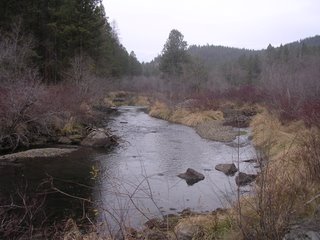
It was a little chilly, but not too bad, and Emma was glad to see there was some snow on the ground. I saw an American dipper, the first I've seen in Oregon, which was neat. It was lovely in an early-winter sort of way, with cloudy skies, dark water, and lots of interesting dried vegetation.
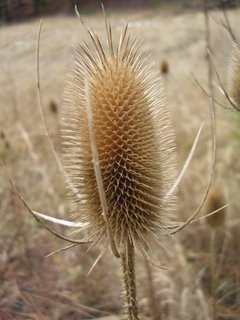
Though teasels are non-native, invasive, and very prickly to walk through, they do have beautiful architectural seed heads. The lichens were also prominant, most noticeably these two...
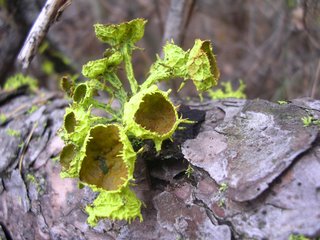
Letharia columbiana
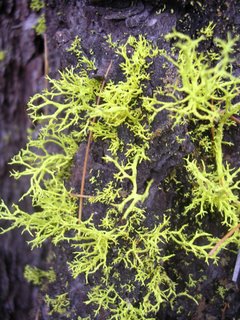
Letharia vulpina
....which were all over the pines and tamaracks. Yes, they really are THAT shockingly chartreuse. Quite stunning, and not something I had ever seen until moving to the West.

It was a little chilly, but not too bad, and Emma was glad to see there was some snow on the ground. I saw an American dipper, the first I've seen in Oregon, which was neat. It was lovely in an early-winter sort of way, with cloudy skies, dark water, and lots of interesting dried vegetation.

Though teasels are non-native, invasive, and very prickly to walk through, they do have beautiful architectural seed heads. The lichens were also prominant, most noticeably these two...

Letharia columbiana

Letharia vulpina
....which were all over the pines and tamaracks. Yes, they really are THAT shockingly chartreuse. Quite stunning, and not something I had ever seen until moving to the West.
Saturday, November 18, 2006
Oh. Oops.
Remember how I said there were going to be 40 repeats of the edging pattern around the urchin shawl? Well, it's really 80. I forgot that it takes TWO rows of edging to nibble up one stitch of the body. You only join the edging to the shawl on the right side rows.
Ah well. I have five repeats done already, I plan to do two more tonight. They're like candy after those long rounds of the body.
Remember how I said there were going to be 40 repeats of the edging pattern around the urchin shawl? Well, it's really 80. I forgot that it takes TWO rows of edging to nibble up one stitch of the body. You only join the edging to the shawl on the right side rows.
Ah well. I have five repeats done already, I plan to do two more tonight. They're like candy after those long rounds of the body.
Friday, November 17, 2006
What the.......
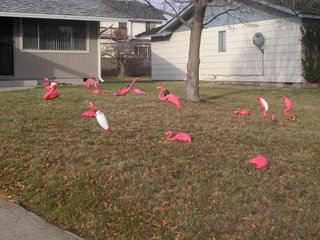
When we looked outside this morning, there was a large flock of pink plastic flamingos in our front yard. Huh? What on earth is going on? Is this our neighbors' way of telling us they don't like us? That they do like us? Some sort of weird Oregon "welcome to the neighborhood" ritual? Or just a driveby flamingo-ing?
Turns out, according to the note taped to our front door, we've been "flocked." The Chemistry Club on campus uses this as a method to raise money to attend a scientific conference later in the year. In order to get the flamingos removed from our yard, we have to make a donation to the Club. We then get to specify who gets "flocked" next.
In a way this is funny, but I'm not sure I'm OK with front yard avian extortion.

When we looked outside this morning, there was a large flock of pink plastic flamingos in our front yard. Huh? What on earth is going on? Is this our neighbors' way of telling us they don't like us? That they do like us? Some sort of weird Oregon "welcome to the neighborhood" ritual? Or just a driveby flamingo-ing?
Turns out, according to the note taped to our front door, we've been "flocked." The Chemistry Club on campus uses this as a method to raise money to attend a scientific conference later in the year. In order to get the flamingos removed from our yard, we have to make a donation to the Club. We then get to specify who gets "flocked" next.
In a way this is funny, but I'm not sure I'm OK with front yard avian extortion.
Wednesday, November 15, 2006
LOOK!!!!!!!!! It's a finished shawl body!!!!!

I finished at about 5:00 this afternoon, after doing three rounds last night (2.5 hours) and five today (4 hours). I now have 1440 stitches on the needle. Whew!
All that's left is to knit the edging, a total of forty repeats. I figure that each repeat will take about 50 minutes, based on the number of stitches. (Though it was totally unplanned, I love that the number of stitches in one edging repeat is 1440, exactly the same as the total stitches in the final round of the body. I don't know why this pleases me so, but it does.)
As far as finished size goes, I think I'm right on target (possibly slightly larger). By holding the center and edge of the shawl, I can easily stretch it to 35 inches, which was the target radius of the body. The edging should be about 5 inches, giving a finished diameter of 80 inches.
I can't wait to get a few edging repeats knit on so I can actually see how my pattern is turning out! I've been going on faith since round 100, (last February!), when I had it off the needles to do a test stretch.

I finished at about 5:00 this afternoon, after doing three rounds last night (2.5 hours) and five today (4 hours). I now have 1440 stitches on the needle. Whew!
All that's left is to knit the edging, a total of forty repeats. I figure that each repeat will take about 50 minutes, based on the number of stitches. (Though it was totally unplanned, I love that the number of stitches in one edging repeat is 1440, exactly the same as the total stitches in the final round of the body. I don't know why this pleases me so, but it does.)
As far as finished size goes, I think I'm right on target (possibly slightly larger). By holding the center and edge of the shawl, I can easily stretch it to 35 inches, which was the target radius of the body. The edging should be about 5 inches, giving a finished diameter of 80 inches.
I can't wait to get a few edging repeats knit on so I can actually see how my pattern is turning out! I've been going on faith since round 100, (last February!), when I had it off the needles to do a test stretch.
Monday, November 13, 2006
I'm still going on the shawl, and am now up to round 282. This is very exciting, because it means that I'm now LESS THAN TEN ROUNDS from finishing the body of the shawl!!! I'm in single digits! I'm loving how each round now puts me nearly a full percentage point closer to completion (there are a LOT of stitches now- 1400 on the last round). I also finished the second skein of yarn a couple rounds ago, which means I've knit 2750 yards so far!
However, a slowly growing lace blob does not an interesting blog photo make. I didn't feel like spinning last night after finishing my two rounds, so I pulled out the little Loomette frame loom that came in with all the stuff for my big loom. I've never tried one of these types of looms before, though I made potholder after potholder out of jersey loops when I was a kid. (And incidentally, I noticed when I was at Dad's house last summer that several of those are still in use! Not bad for probably 25- to 30-year-old potholders!)
Anyway, the Loomette is pretty cool. You take one continuous strand of yarn, and by winding it around the pins a certain way into three layers, then needleweaving a fourth layer, you create a self contained little piece of fabric with selvedges on all four sides.
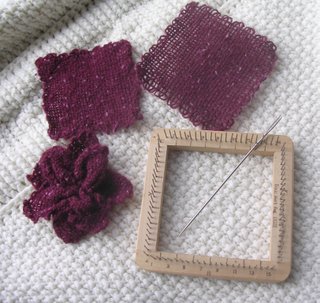
I just made plain weave squares last night, but you can also make lots of different patterns. There's a great website, eLoomaNation, that has pdf's of lots of old pattern books for this type loom. Each square takes about 10 minutes to make.
I used some coned yarn that I've had around for a while to make these. It's 100% wool, but kind of weird. It's a singles yarn, just one ply, with flecks of lighter fiber spun in. It's also somewhat scratchy and stiff, and it seems to be almost felted. Not a great yarn, but the three pound cone was free, and it's a pretty color. You can see in the picture above how the squares looked after coming off the loom (4" square) and after washing (3.5" square). I was amazed at how the yarn changed with a soapy wash and a bit of fulling. There must have been spinning oil in there, because it bloomed and softened considerably. It also lost a bit of excess dye.
I took two of the squares and pulled up one thread in each direction, from the center, to make this little gathered flower.
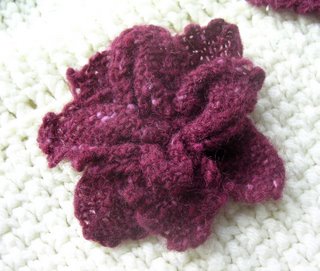
I think with some beading and a pin back, this would be a cute embellishment to go on a felted bag or hat.
-----------------
(edited to make the link work- thanks Leigh!)
However, a slowly growing lace blob does not an interesting blog photo make. I didn't feel like spinning last night after finishing my two rounds, so I pulled out the little Loomette frame loom that came in with all the stuff for my big loom. I've never tried one of these types of looms before, though I made potholder after potholder out of jersey loops when I was a kid. (And incidentally, I noticed when I was at Dad's house last summer that several of those are still in use! Not bad for probably 25- to 30-year-old potholders!)
Anyway, the Loomette is pretty cool. You take one continuous strand of yarn, and by winding it around the pins a certain way into three layers, then needleweaving a fourth layer, you create a self contained little piece of fabric with selvedges on all four sides.

I just made plain weave squares last night, but you can also make lots of different patterns. There's a great website, eLoomaNation, that has pdf's of lots of old pattern books for this type loom. Each square takes about 10 minutes to make.
I used some coned yarn that I've had around for a while to make these. It's 100% wool, but kind of weird. It's a singles yarn, just one ply, with flecks of lighter fiber spun in. It's also somewhat scratchy and stiff, and it seems to be almost felted. Not a great yarn, but the three pound cone was free, and it's a pretty color. You can see in the picture above how the squares looked after coming off the loom (4" square) and after washing (3.5" square). I was amazed at how the yarn changed with a soapy wash and a bit of fulling. There must have been spinning oil in there, because it bloomed and softened considerably. It also lost a bit of excess dye.
I took two of the squares and pulled up one thread in each direction, from the center, to make this little gathered flower.

I think with some beading and a pin back, this would be a cute embellishment to go on a felted bag or hat.
-----------------
(edited to make the link work- thanks Leigh!)
Friday, November 10, 2006
Making great progress on the shawl- I'm up to round 274! This two-row-a-day thing is really working (though I've exceeded that goal recently, and have done ten rounds in three days!) Only 18 rounds left...
Other random thoughts: I love having a clothesline again. I had one in North Carolina, but the past five years in Washington, I didn't. There's really nothing that compares to line-dried sheets.

Haven't used a dryer since the last laundromat visit on Sept. 24, before the movers brought our washing machine, and am loving it.
Other random thoughts: I love having a clothesline again. I had one in North Carolina, but the past five years in Washington, I didn't. There's really nothing that compares to line-dried sheets.

Haven't used a dryer since the last laundromat visit on Sept. 24, before the movers brought our washing machine, and am loving it.
Thursday, November 09, 2006
Well, what do I see here?

SNOW! This is the closest we've come yet this fall to getting the white stuff at our new home in Oregon. The tops of the hills all around have a dusting this morning, though down in the town we just had rain. This hill is the beginning of the Blue Mountains (west of town), pretty much behind our house.
After taking Shaun to work this morning so we could have the car and go grocery shopping later, Emma and I decided to drive around a bit and see the pretty scenery. We drove up a dirt road we haven't explored yet, and it was indeed very pretty.
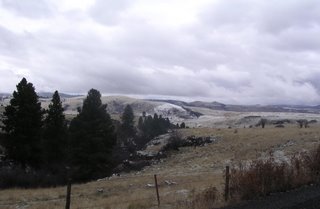
This road is off one of my favorite bird routes that I discovered the first week we were here. On the way back to town, I saw a new bird for my list- Snow Buntings! This is the second new species I've seen this week; I also saw a Northern Shrike on Nov. 4. The bird list is now up to 396!

SNOW! This is the closest we've come yet this fall to getting the white stuff at our new home in Oregon. The tops of the hills all around have a dusting this morning, though down in the town we just had rain. This hill is the beginning of the Blue Mountains (west of town), pretty much behind our house.
After taking Shaun to work this morning so we could have the car and go grocery shopping later, Emma and I decided to drive around a bit and see the pretty scenery. We drove up a dirt road we haven't explored yet, and it was indeed very pretty.

This road is off one of my favorite bird routes that I discovered the first week we were here. On the way back to town, I saw a new bird for my list- Snow Buntings! This is the second new species I've seen this week; I also saw a Northern Shrike on Nov. 4. The bird list is now up to 396!
Monday, November 06, 2006
This year was Emma's first "real" Halloween where she went trick-or-treating and everything, so we got a pumpkin and did the whole carving thing. She had a blast, especially pulling the seeds out of the inside and then roasting them in the oven. (And eating them.)

However, every year that I've had a jack-o-lantern for Halloween I've felt guilty for getting a pumpkin, carving it, and then just having it sit on the step until it goes bad. Pumpkins are food, after all, and it seemed like a waste. (I feel somewhat the same way about Christmas trees, but that's a story for another time...) This year, I decided to do something about it.
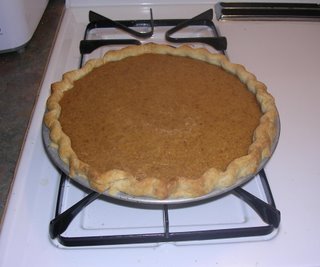
In addition to our jack-o-lantern, I also bought three of the little pie pumpkins from the grocery store. On November 1, I spent the better part of the day baking pumpkin and pureeing it to put in the freezer.

I now have 12-pies-worth of pumpkin in the freezer, (in two-cup portions), one baked pie (which I made yesterday), and a dish of roasted seeds. I also made a batch of orange-cranberry relish to put in the freezer, because cranberries were on sale at the grocery store last week.
The three pie pumpkins made six cups of puree (three pies), and the jack-o-lantern made 20 cups of puree (ten pies) . The jack-o-lantern had much paler flesh and lost more water after baking than the pie pumpkins, and it'll be interesting how the flavor differs. The pie I made yesterday was from the Jack-o-Lantern, and while it was good, it didn't have quite as much flavor as the canned pumpkin that I'm used to. The texture was the same as commercial pumpkin, though, which I was glad to see. I'm thinking that a bit more spices next time will compensate for the blander pumpkin. I'm hopeful that the pie pumpkins will have a stronger pumpkin flavor.
Overall, I'm pleased with this experiment, my first time making pie from a raw pumpkin. Using the pie pumpkins was ridiculously easy. Cut in half, bake cut-side down at 350 F for an hour, slip the meat from the skins, whiz in the food processor, freeze. The jack-o-lantern was slightly more problematic, since it had to be cut up, baked in batches, and wanted to dry out in the oven so had to be covered. Because it was bigger and had to drain longer, it also was much more of an undertaking. But I now have enough filling for an entire winter's worth (and then some) of Shaun's favorite pie, and I don't have to buy canned pumpkin anymore! Not that it's expensive, but it's so much more satisfying to have done it myself.....

However, every year that I've had a jack-o-lantern for Halloween I've felt guilty for getting a pumpkin, carving it, and then just having it sit on the step until it goes bad. Pumpkins are food, after all, and it seemed like a waste. (I feel somewhat the same way about Christmas trees, but that's a story for another time...) This year, I decided to do something about it.

In addition to our jack-o-lantern, I also bought three of the little pie pumpkins from the grocery store. On November 1, I spent the better part of the day baking pumpkin and pureeing it to put in the freezer.

I now have 12-pies-worth of pumpkin in the freezer, (in two-cup portions), one baked pie (which I made yesterday), and a dish of roasted seeds. I also made a batch of orange-cranberry relish to put in the freezer, because cranberries were on sale at the grocery store last week.
The three pie pumpkins made six cups of puree (three pies), and the jack-o-lantern made 20 cups of puree (ten pies) . The jack-o-lantern had much paler flesh and lost more water after baking than the pie pumpkins, and it'll be interesting how the flavor differs. The pie I made yesterday was from the Jack-o-Lantern, and while it was good, it didn't have quite as much flavor as the canned pumpkin that I'm used to. The texture was the same as commercial pumpkin, though, which I was glad to see. I'm thinking that a bit more spices next time will compensate for the blander pumpkin. I'm hopeful that the pie pumpkins will have a stronger pumpkin flavor.
Overall, I'm pleased with this experiment, my first time making pie from a raw pumpkin. Using the pie pumpkins was ridiculously easy. Cut in half, bake cut-side down at 350 F for an hour, slip the meat from the skins, whiz in the food processor, freeze. The jack-o-lantern was slightly more problematic, since it had to be cut up, baked in batches, and wanted to dry out in the oven so had to be covered. Because it was bigger and had to drain longer, it also was much more of an undertaking. But I now have enough filling for an entire winter's worth (and then some) of Shaun's favorite pie, and I don't have to buy canned pumpkin anymore! Not that it's expensive, but it's so much more satisfying to have done it myself.....
Today I have a knitting update and a spinning question to answer.
First, the shawl. I have completed Round 261, which means I only have 30 more rounds to go!!! Oh, and the edging. Right. But it's getting there!

A question on spinning itty bitty yarn, from bibliotecaria in the comments from the last post: "Can you share some more details of how you drafted it? Set up the spinning wheel? Was it a special flyer or bobbin?" Gladly!!
This was spun on my Schacht Matchless wheel, with the standard bobbin and flyer that came with the wheel. I have the wheel set up for Scotch tension, and am using a thin cotton brake band (#50 crochet thread) and a soft spring. I used the smallest flyer whorl I have, which has a ratio of 13:1. This whorl is listed as giving a 15.5:1 ratio, but I use a stretchy polycord drive band, which has a slightly larger diameter than the Schacht cotton drive band, hence the lower ratio. They do make smaller whorls, up to 27.5:1, but I don't have that one.....yet.
To start, I pull off a piece of roving about five inches long. The silk roving I have is fairly thick, so I predraft extensively before I spin.

On the top is the roving as it comes out of the bag. In the middle, it's spread out so I can see the natural thin spots where it will be easy to split lengthwise. In this case, I would probably divide it into three strips. The piece on the bottom is what I spin from, after splitting the roving and attenuating each strip to about half the thickness of my little finger. I cannot emphasize enough the value of predrafting. It makes spinning fine MUCH easier. But don't do too much at once, because it wants to fly everywhere after it's predrafted.
After the fiber is ready, I just spin. I use a modified worsted technique, always keeping the twist under control- at no time is the twist allowed between my hands, into the drafting triangle. I say "modified" worsted because I have a relatively low ratio whorl for spinning laceweight yarn, so I do two treadles for each inch I draft out, giving about 26 twists per inch in the finished singles. If I had a higher ratio, I would just treadle once. Either way, it takes a lot of twist.

This is what the drafting triangle looks like. Obviously, I would normally be using two hands, but have you ever tried to take a picture of yourself while spinning? Not easy. My left hand would be the back hand, controlling the fiber mass, while my right hand is in front controlling the twist. My sequence of steps is this:
1) Draft one inch by pulling forward with the right hand, pinching off the twist, while treadling once.
2) Smooth in the twist with the right hand by sliding the fingers back toward the left hand. This requires a slight (and I do mean slight) lessening of pinching pressure, but not so much that the twist escapes into the area between my hands. While this slide occurs, treadle again.
It's pull/treadle, slide/treadle. Repeat ad infinitum.
For plying, the sequence is the same, but instead of drafting forward one inch of fiber at a time, I pull forward two inches of singles per two treadles, then smooth them together with the third treadle while sliding my right hand back. This gives slightly less plying twist than singles twist, which produces a balanced yarn. In plying, as in drafting, I don't let the twist between my hands. The reason is the same- to catch in any stray ends and make the yarn as smooth as possible.
Three more tips-
First, when spinning silk or other fine fibers, I don't use my regular lapcloth. I made mine out of duck cloth, and the surface is just too "grabby." I use a silky scarf (I think it's probably polyester, but as long as it's slippery, it'll work) on my lap, otherwise the silk fibers stick to me, the cloth, and everything in the vicinity. The smooth fabric keeps everything under control nicely. A solid color would be better, but Emma happened to have the one in the above pictures in her dressup box, so I borrowed it.
Second, I think plying from rewound bobbins is especially helpful in this situation, when a super-smooth yarn is the goal. That way, when you do the smoothing step during plying, you're going in the same direction that you smoothed the singles, and the fibers lay even flatter. If I didn't rewind the bobbins, I'd be raising the nap on the singles when I plyed, and it could be fuzzy.
Third, it can be helpful to slightly raise your forward hand during the sliding/smoothing steps of both spinning and plying. This helps keep the twist from running up in between your hands when you release the pinch slightly.
So there you go, probably more than you ever wanted to know about how I spin. It sounds a lot more complicated than it is. Truly, it becomes automatic and relaxing.
First, the shawl. I have completed Round 261, which means I only have 30 more rounds to go!!! Oh, and the edging. Right. But it's getting there!

A question on spinning itty bitty yarn, from bibliotecaria in the comments from the last post: "Can you share some more details of how you drafted it? Set up the spinning wheel? Was it a special flyer or bobbin?" Gladly!!
This was spun on my Schacht Matchless wheel, with the standard bobbin and flyer that came with the wheel. I have the wheel set up for Scotch tension, and am using a thin cotton brake band (#50 crochet thread) and a soft spring. I used the smallest flyer whorl I have, which has a ratio of 13:1. This whorl is listed as giving a 15.5:1 ratio, but I use a stretchy polycord drive band, which has a slightly larger diameter than the Schacht cotton drive band, hence the lower ratio. They do make smaller whorls, up to 27.5:1, but I don't have that one.....yet.
To start, I pull off a piece of roving about five inches long. The silk roving I have is fairly thick, so I predraft extensively before I spin.

On the top is the roving as it comes out of the bag. In the middle, it's spread out so I can see the natural thin spots where it will be easy to split lengthwise. In this case, I would probably divide it into three strips. The piece on the bottom is what I spin from, after splitting the roving and attenuating each strip to about half the thickness of my little finger. I cannot emphasize enough the value of predrafting. It makes spinning fine MUCH easier. But don't do too much at once, because it wants to fly everywhere after it's predrafted.
After the fiber is ready, I just spin. I use a modified worsted technique, always keeping the twist under control- at no time is the twist allowed between my hands, into the drafting triangle. I say "modified" worsted because I have a relatively low ratio whorl for spinning laceweight yarn, so I do two treadles for each inch I draft out, giving about 26 twists per inch in the finished singles. If I had a higher ratio, I would just treadle once. Either way, it takes a lot of twist.

This is what the drafting triangle looks like. Obviously, I would normally be using two hands, but have you ever tried to take a picture of yourself while spinning? Not easy. My left hand would be the back hand, controlling the fiber mass, while my right hand is in front controlling the twist. My sequence of steps is this:
1) Draft one inch by pulling forward with the right hand, pinching off the twist, while treadling once.
2) Smooth in the twist with the right hand by sliding the fingers back toward the left hand. This requires a slight (and I do mean slight) lessening of pinching pressure, but not so much that the twist escapes into the area between my hands. While this slide occurs, treadle again.
It's pull/treadle, slide/treadle. Repeat ad infinitum.
For plying, the sequence is the same, but instead of drafting forward one inch of fiber at a time, I pull forward two inches of singles per two treadles, then smooth them together with the third treadle while sliding my right hand back. This gives slightly less plying twist than singles twist, which produces a balanced yarn. In plying, as in drafting, I don't let the twist between my hands. The reason is the same- to catch in any stray ends and make the yarn as smooth as possible.
Three more tips-
First, when spinning silk or other fine fibers, I don't use my regular lapcloth. I made mine out of duck cloth, and the surface is just too "grabby." I use a silky scarf (I think it's probably polyester, but as long as it's slippery, it'll work) on my lap, otherwise the silk fibers stick to me, the cloth, and everything in the vicinity. The smooth fabric keeps everything under control nicely. A solid color would be better, but Emma happened to have the one in the above pictures in her dressup box, so I borrowed it.
Second, I think plying from rewound bobbins is especially helpful in this situation, when a super-smooth yarn is the goal. That way, when you do the smoothing step during plying, you're going in the same direction that you smoothed the singles, and the fibers lay even flatter. If I didn't rewind the bobbins, I'd be raising the nap on the singles when I plyed, and it could be fuzzy.
Third, it can be helpful to slightly raise your forward hand during the sliding/smoothing steps of both spinning and plying. This helps keep the twist from running up in between your hands when you release the pinch slightly.
So there you go, probably more than you ever wanted to know about how I spin. It sounds a lot more complicated than it is. Truly, it becomes automatic and relaxing.
Wednesday, November 01, 2006
Well, I'm still whirling along on the urchin shawl (...you know, like whirling a pizza dough to stretch it out, only slower...yes, I have a strange mind...), and am now up to round 250! I think I'm actually getting there! For some reason, it seems like the recent rounds are going by faster then the earlier ones. (They aren't really, it just seems like it.) There was a bit in the middle where it felt like each round took f...o...r...e...v...e...r.
Perhaps it helped that we finally got the necessary wiring-connector-converter-adapter thingy to allow our DVD player to communicate with our TV, and I can now listen to my favorite movies while I knit. When you've seen Lord of the Rings That. Many. Times. the soundtrack alone is enough. The pictures just play along in my head as I happily count out my lace. We had the DVD player routed through our broken VCR when we were in Washington, but couldn't see the logic of bringing a piece of defunct electronics along on the move. Of course, when we got here and were connecting all the wires together, we realized why we had kept said defunct electronics; namely, that the 3 year old DVD player doesn't speak the same language as the 12 year old TV. Anyway, when my dad was here a couple weeks ago, he offered to send us the adapter he was no longer using since he recently bought abig huge giant over the top very nice new TV. The adapter works, and we can watch DVDs again.
I worked out something of a system for fiber work in the past week. I'm concentrating on the urchin shawl, but I have to have something else going as well, preferrably non-knitting, so different muscles are used. I find that spinning is a good complement to knitting. It rests my hands, eyes and brain, exercises my feet, and lets me sit in a different posture.
So my daily goal is to knit at least two rounds on the shawl, and spin if I'm still feeling crafty and awake. The spinning has been the almost-froghair silk that I posted about here and here. I started on a new bobbin after that last picture, the bobbin with eight hours on it. I weighed it to find out how much silk singles was on it, and portioned out an equal weight of roving. It was only 16.5 grams(0.56 oz)! I spent the next few days spinning that. It also took eight hours.
I then rewound both bobbins onto 6" weaving bobbins in preparation for plying. I wish I had remembered to take a picture of the weaving bobbins with the silk on them, they were beautiful, and sixteen hours of spinning only produced enough singles to fill one third of each bobbin.
I plyed last night and this morning, and ended up with this:
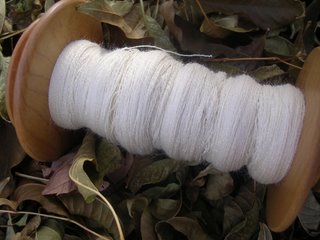
After skeining it off onto the niddy-noddy to measure the yardage,
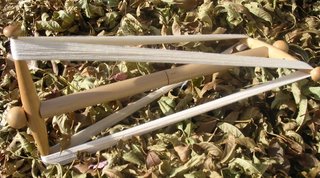
a quick dip in a warm bath and a breezy drying outside,

and I have this!
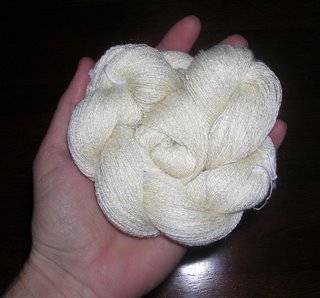
That little handful is 33 grams (1.16 oz), and 680 yards of 70 wraps-per-inch two ply. It represents sixteen hours of spinning, five hours of plying, and 30 minutes of skeining. The grist works out to just under 10,000 yards per pound. (!)
While I was plying the two bobbins together, the second one only had this much left over when the first ran out.
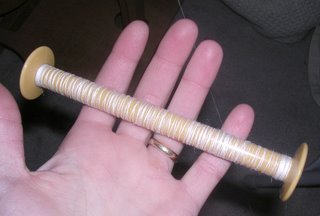
There is a five yard length of yarn at the end of the skein that is plyed from both ends of the leftover bobbin. That means that one bobbin only had 10 yards more singles than the other. Fairly consistent, considering how long that thread was!

I'm not sure what this is going to become. Maybe knitted lace, maybe something woven. I may spin up a whole bunch more of this and knit a gigantic, diaphanous, floaty shawl. Or I may use it as warp and weave myself something beautiful and impractical. This yarn is very strong- Neither the singles nor the plied yarn broke during the whole process. Well, OK, the singles did break once during plying, but it was not the fault of the singles, it was because Emma ran by and got caught on one of the plies.
I'm still working on my fine-spinning skills, but this is getting there. I think patience is one of the biggest components of spinning fine. You spin and spin (and spin and spin and spin) and the bobbin still looks mostly empty. It's worth it, though.
Perhaps it helped that we finally got the necessary wiring-connector-converter-adapter thingy to allow our DVD player to communicate with our TV, and I can now listen to my favorite movies while I knit. When you've seen Lord of the Rings That. Many. Times. the soundtrack alone is enough. The pictures just play along in my head as I happily count out my lace. We had the DVD player routed through our broken VCR when we were in Washington, but couldn't see the logic of bringing a piece of defunct electronics along on the move. Of course, when we got here and were connecting all the wires together, we realized why we had kept said defunct electronics; namely, that the 3 year old DVD player doesn't speak the same language as the 12 year old TV. Anyway, when my dad was here a couple weeks ago, he offered to send us the adapter he was no longer using since he recently bought a
I worked out something of a system for fiber work in the past week. I'm concentrating on the urchin shawl, but I have to have something else going as well, preferrably non-knitting, so different muscles are used. I find that spinning is a good complement to knitting. It rests my hands, eyes and brain, exercises my feet, and lets me sit in a different posture.
So my daily goal is to knit at least two rounds on the shawl, and spin if I'm still feeling crafty and awake. The spinning has been the almost-froghair silk that I posted about here and here. I started on a new bobbin after that last picture, the bobbin with eight hours on it. I weighed it to find out how much silk singles was on it, and portioned out an equal weight of roving. It was only 16.5 grams(0.56 oz)! I spent the next few days spinning that. It also took eight hours.
I then rewound both bobbins onto 6" weaving bobbins in preparation for plying. I wish I had remembered to take a picture of the weaving bobbins with the silk on them, they were beautiful, and sixteen hours of spinning only produced enough singles to fill one third of each bobbin.
I plyed last night and this morning, and ended up with this:

After skeining it off onto the niddy-noddy to measure the yardage,

a quick dip in a warm bath and a breezy drying outside,

and I have this!

That little handful is 33 grams (1.16 oz), and 680 yards of 70 wraps-per-inch two ply. It represents sixteen hours of spinning, five hours of plying, and 30 minutes of skeining. The grist works out to just under 10,000 yards per pound. (!)
While I was plying the two bobbins together, the second one only had this much left over when the first ran out.

There is a five yard length of yarn at the end of the skein that is plyed from both ends of the leftover bobbin. That means that one bobbin only had 10 yards more singles than the other. Fairly consistent, considering how long that thread was!

I'm not sure what this is going to become. Maybe knitted lace, maybe something woven. I may spin up a whole bunch more of this and knit a gigantic, diaphanous, floaty shawl. Or I may use it as warp and weave myself something beautiful and impractical. This yarn is very strong- Neither the singles nor the plied yarn broke during the whole process. Well, OK, the singles did break once during plying, but it was not the fault of the singles, it was because Emma ran by and got caught on one of the plies.
I'm still working on my fine-spinning skills, but this is getting there. I think patience is one of the biggest components of spinning fine. You spin and spin (and spin and spin and spin) and the bobbin still looks mostly empty. It's worth it, though.
Subscribe to:
Comments (Atom)

